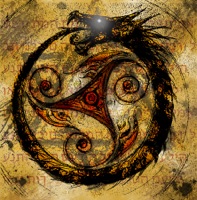Uroboros
Origin
From Greek (drakōn) ouroboros ‘(snake) devouring its tail.’
Definition
- 1:a circular symbol depicting a snake, or less commonly a dragon, swallowing its tail, as an emblem of wholeness or infinity.
Description
The Ouroboros or Uroboros (/jʊərɵˈbɒrəs/; /ɔːˈrɒbɔrəs/, from the Greek οὐροβόρος ὄφις tail-devouring snake) is an ancient symbol depicting a serpent or dragon eating its own tail.
The Ouroboros often symbolizes self-reflexivity or cyclicality, especially in the sense of something constantly re-creating itself, the eternal return, and other things such as the phoenix which operate in cycles that begin anew as soon as they end. It can also represent the idea of primordial unity related to something existing in or persisting from the beginning with such force or qualities it cannot be extinguished. While first emerging in Ancient Egypt, the Ouroboros has been important in religious and mythological symbolism, but has also been frequently used in alchemical illustrations, where it symbolizes the circular nature of the alchemist's opus. It is also often associated with Gnosticism, and Hermeticism.
Carl Jung interpreted the Ouroboros as having an archetypal significance to the human psyche. The Jungian psychologist Erich Neumann writes of it as a representation of the pre-ego "dawn state", depicting the undifferentiated infancy experience of both mankind and the individual child.
